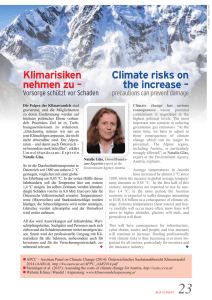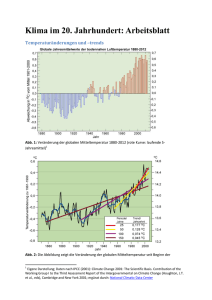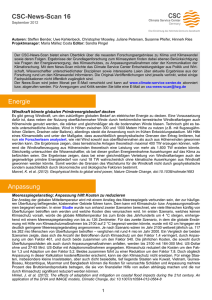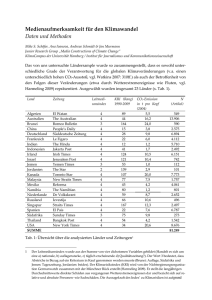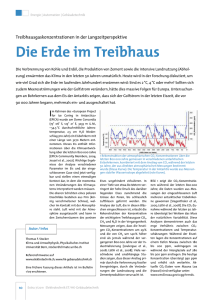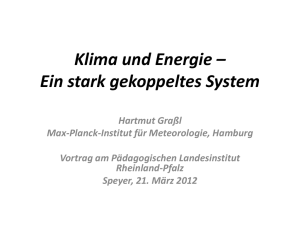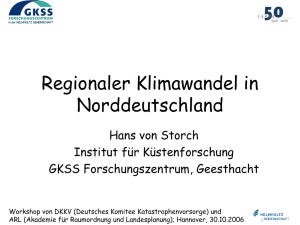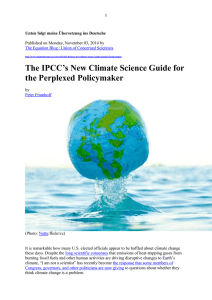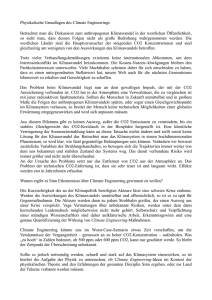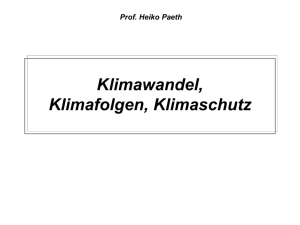Dokumentation Thomas Stocker
Werbung
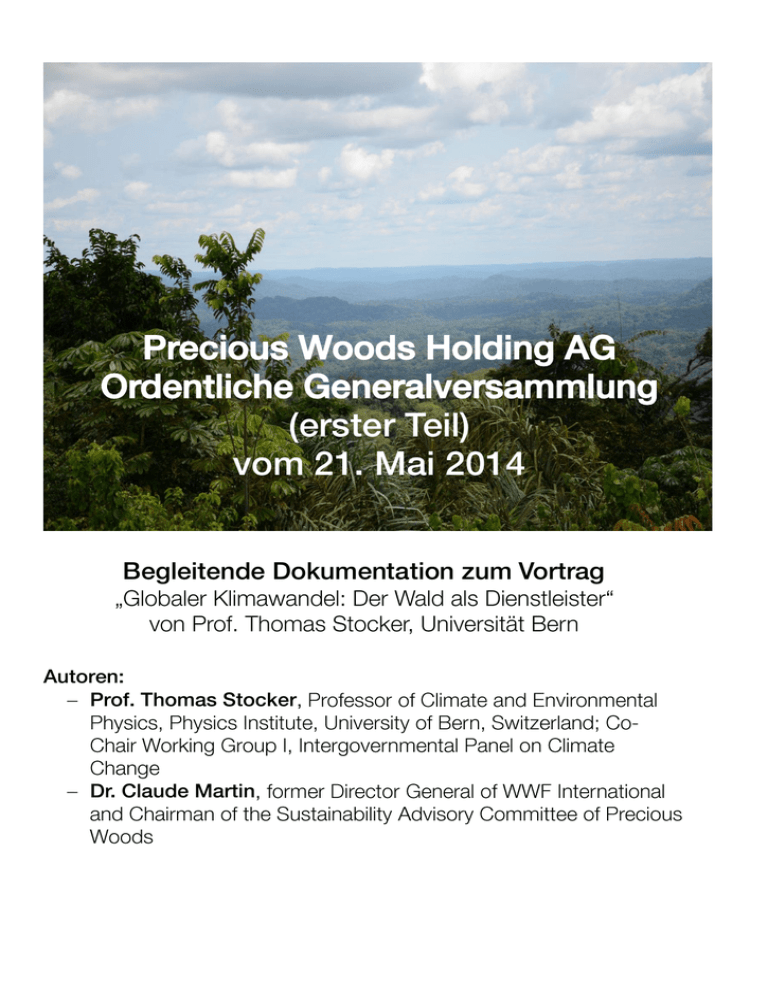
Precious Woods Holding AG Ordentliche Generalversammlung (erster Teil) vom 21. Mai 2014 Begleitende Dokumentation zum Vortrag Autoren: Prof. Thomas Stocker, Dr. Claude Martin KLIMAWANDEL 2013 Physikalische Grundlagen Hauptaussagen1 aus der Zusammenfassung für politische Entscheidungsträger Beobachtete Änderungen im Klimasystem Die Erwärmung des Klimasystems ist eindeutig, und viele dieser seit den 1950er Jahren beobachteten Veränderungen sind seit Jahrzehnten bis Jahrtausenden nie aufgetreten. Die Atmosphäre und der Ozean haben sich erwärmt, die Schnee- und Eismengen sind zurückgegangen, der Meeresspiegel ist angestiegen und die Konzentrationen der Treibhausgase haben zugenommen. Jedes der letzten drei Jahrzehnte war an der Erdoberfläche sukzessive wärmer als alle vorangehenden Jahrzehnte seit 1850. In der Nordhemisphäre war 1983–2012 wahrscheinlich2 die wärmste 30-Jahr-Periode der letzten 1400 Jahre (mittleres Vertrauen2). Die Erwärmung des Ozeans dominiert den Zuwachs der im Klimasystem gespeicherten Energie und macht mehr als 90% der zwischen 1971 und 2010 akkumulierten Energie aus (hohes Vertrauen). Es ist praktisch sicher, dass sich der obere Ozean (0–700m) von 1971 bis 2010 erwärmt hat, und wahrscheinlich, dass er auch zwischen 1870 und 1971 wärmer geworden ist. Während den letzten beiden Jahrzehnten haben die Eisschilder in Grönland und in der Antarktis an Masse verloren, die Gletscher sind fast überall in der Welt weiter abgeschmolzen, und die Ausdehnung des arktischen Meereises sowie der Schneebedeckung in der Nordhemisphäre im Frühjahr haben weiter abgenommen (hohes Vertrauen). Die Geschwindigkeit des Meeresspiegelanstiegs seit Mitte des 19. Jahrhunderts war größer als die mittlere Geschwindigkeit in den vorangegangenen zwei Jahrtausenden (hohes Vertrauen). Im Zeitraum 1901 bis 2010 ist der mittlere globale Meeresspiegel um 0.19 [0.17 bis 0.21] m gestiegen. Die Konzentrationen von Kohlendioxid, Methan und Lachgas sind auf Werte angestiegen, die seit mindestens den letzten 800'000 Jahren nicht vorgekommen sind. Die Kohlendioxid-Konzentrationen sind seit der vorindustriellen Zeit um 40% angestiegen, primär durch die Emissionen aus fossilen Brennstoffen und sekundär durch Netto-Emissionen aufgrund von Landnutzungsänderungen. Der Ozean hat ungefähr 30% des emittierten anthropogenen Kohlendioxids aufgenommen und dadurch eine Versauerung erfahren. Treiber des Klimawandels Der gesamte anthropogene Strahlungsantrieb ist positiv und hat zu einer Aufnahme von Energie durch das Klimasystem geführt. Der größte Beitrag zum gesamten Strahlungsantrieb wurde durch den Anstieg der atmosphärischen CO2-Konzentration seit 1750 verursacht. 2 Der in kursiver Schrift angegebene Grad der Verlässlichkeit von Schlüsselergebnissen basiert auf der Einschätzung des zugrundeliegenden wissenschaftlichen Verständnisses durch das Autorenteam und wird als Vertrauensniveau ausgedrückt (sehr tief, tief, mittel, hoch und sehr hoch), wenn möglich auch quantitativ mit einer Wahrscheinlichkeitsangabe (praktisch sicher 99-100% Wahrscheinlichkeit, äußerst wahrscheinlich 95-100%, sehr wahrscheinlich 90-100%, wahrscheinlich 66-100%, eher wahrscheinlich als nicht 50-100%) WGI Technical Support Unit c/o University of Bern Zaehringerstrasse 25 3012 Bern Switzerland telephone +41 31 631 5616 fax +41 31 631 5615 email [email protected] www.climatechange2013.org Photo © Yann Arthus-Bertrand / Altitude 1 Hauptaussagen sind die übergreifenden hervorgehobenen Schlussfolgerungen der genehmigten Zusammenfassung für politische Entscheidungsträger (SPM), die, zusammen genommen, eine prägnante Geschichte ergeben. Die vier Aussagen in den Kästen sind jene, welche den Sachstand in den Sektionen B-E des SPM zusammenfassen. Hauptaussagen aus der Zusammenfassung für politische Entscheidungsträger Verständnis des Klimasystems und dessen jüngsten Änderungen Der menschliche Einfluss auf das Klimasystem ist klar. Das ist offensichtlich aufgrund der ansteigenden Treibhausgaskonzentrationen in der Atmosphäre, dem positiven Strahlungsantrieb, der beobachteten Erwärmung und des Verständnisses des Klimasystems. Die Klimamodelle sind seit dem AR4 besser geworden. Die Modelle geben die beobachteten Muster und Trends über viele Dekaden der Erdoberflächentemperatur im kontinentalen Maßstab wieder, einschließlich der stärkeren Erwärmung seit Mitte des 20. Jahrhunderts und der unmittelbar auf große Vulkaneruptionen folgenden Abkühlung (sehr hohes Vertrauen). Beobachtungs- und Modellstudien der Temperaturveränderung, der klimatischen Rückkopplungen und der Veränderung der Energiebilanz der Erde zusammen geben Vertrauen in das Ausmaß der globalen Erwärmung als Folge des vergangenen und zukünftigen Antriebs. Der menschliche Einfluss wurde in der Erwärmung der Atmosphäre und des Ozeans, in Veränderungen des globalen Wasserkreislaufs, in der Abnahme von Schnee und Eis, im Anstieg des mittleren globalen Meeresspiegels und in Veränderungen einiger Klimaextreme erkannt. Die Indizien für den menschlichen Einfluss haben seit dem AR4 zugenommen. Es ist äußerst wahrscheinlich, dass der menschliche Einfluss die Hauptursache der beobachteten Erwärmung seit Mitte des 20. Jahrhunderts war. Zukünftiger globaler und regionaler Klimawandel Fortgesetzte Emissionen von Treibhausgasen werden eine weitere Erwärmung und Veränderungen in allen Komponenten des Klimasystems bewirken. Die Begrenzung des Klimawandels erfordert beträchtliche und anhaltende Reduktionen der TreibhausgasEmissionen. Die Änderung der globalen Erdoberflächentemperatur wird am Ende des 21. Jahrhunderts, bezogen auf 1850–1900, für alle RCPSzenarien ausser RCP2.6 wahrscheinlich 1.5°C übersteigen. Sie wird für RCP6.0 und RCP8.5 wahrscheinlich mehr als 2°C sein und für RCP4.5 eher wahrscheinlich als nicht 2°C übersteigen. Die Erwärmung wird unter allen RCP-Szenarien ausser RCP2.6 über 2100 hinaus weitergehen. Die Erwärmung wird weiterhin Schwankungen auf Zeitskalen von Jahren bis Jahrzehnten aufweisen und regional nicht einheitlich sein. Änderungen im globalen Wasserkreislauf als Folge der Erwärmung im 21. Jahrhundert werden nicht einheitlich sein. Die Gegensätze in den Niederschlägen zwischen trockenen und feuchten Regionen und zwischen feuchten und trockenen Jahreszeiten werden zunehmen, auch wenn es regionale Ausnahmen geben kann. Der globale Ozean wird sich im 21. Jahrhundert weiter erwärmen. Wärme wird von der Oberfläche in den tiefen Ozean vordringen und die Ozeanzirkulation beeinflussen. Es ist sehr wahrscheinlich, dass im 21. Jahrhundert bei einem Anstieg der mittleren globalen Erdoberflächentemperatur die arktische Meereisbedeckung weiter an Fläche verlieren und ausdünnen wird und die Schneebedeckung im Frühjahr auf der Nordhemisphäre abnehmen wird. Das Gletschervolumen wird weiter zurückgehen. Der mittlere globale Meeresspiegel wird im 21. Jahrhundert weiter ansteigen. Unter allen RCP-Szenarien wird die Geschwindigkeit des Meeresspiegelanstiegs die von 1971 bis 2010 beobachtete Geschwindigkeit aufgrund der zunehmenden Ozeanerwärmung und des Massenverlustes von Gletschern und Eisschildern sehr wahrscheinlich übertreffen. Der Klimawandel wird die Kohlenstoffkreislauf-Prozesse in einer Weise beeinflussen, welche den Anstieg von CO2 in der Atmosphäre verstärken wird (hohes Vertrauen). Die weitere Aufnahme von Kohlenstoff durch den Ozean wird die Ozean-Versauerung erhöhen. Die kumulativen CO2-Emissionen bestimmen weitgehend die mittlere globale Erwärmung der Erdoberfläche bis ins späte 21. Jahrhundert und darüber hinaus. Die meisten Aspekte des Klimawandels werden für viele Jahrhunderte bestehen bleiben, auch wenn die Emissionen von Treibhausgasen gestoppt werden. Dies bedeutet einen unabwendbaren Klimawandel von beträchtlichem Ausmaß über mehrere Jahrhunderte hinweg, der durch vergangene, gegenwärtige und zukünftige Emissionen von CO2 verursacht wird. CLIMATE CHANGE 2013 The Physical Science Basis Headline Statements from the Summary for Policymakers * Observed Changes in the Climate System Warming of the climate system is unequivocal, and since the 1950s, many of the observed changes are unprecedented over decades to millennia. The atmosphere and ocean have warmed, the amounts of snow and ice have diminished, sea level has risen, and the concentrations of greenhouse gases have increased. Each of the last three decades has been successively warmer at the Earth’s surface than any preceding decade since 1850. In the Northern Hemisphere, 1983–2012 was likely the warmest 30-year period of the last 1400 years (medium confidence). Ocean warming dominates the increase in energy stored in the climate system, accounting for more than 90% of the energy accumulated between 1971 and 2010 (high confidence). It is virtually certain that the upper ocean (0–700 m) warmed from 1971 to 2010, and it likely warmed between the 1870s and 1971. Over the last two decades, the Greenland and Antarctic ice sheets have been losing mass, glaciers have continued to shrink almost worldwide, and Arctic sea ice and Northern Hemisphere spring snow cover have continued to decrease in extent (high confidence). The rate of sea level rise since the mid-19th century has been larger than the mean rate during the previous two millennia (high confidence). Over the period 1901 to 2010, global mean sea level rose by 0.19 [0.17 to 0.21] m. The atmospheric concentrations of carbon dioxide, methane, and nitrous oxide have increased to levels unprecedented in at least the last 800,000 years. Carbon dioxide concentrations have increased by 40% since pre-industrial times, primarily from fossil fuel emissions and secondarily from net land use change emissions. The ocean has absorbed about 30% of the emitted anthropogenic carbon dioxide, causing ocean acidification. Drivers of Climate Change Total radiative forcing is positive, and has led to an uptake of energy by the climate system. The largest contribution to total radiative forcing is caused by the increase in the atmospheric concentration of CO2 since 1750. Zaehringerstrasse 25 3012 Bern Switzerland telephone +41 31 631 5616 fax +41 31 631 5615 email [email protected] www.climatechange2013.org Photo © Yann Arthus-Bertrand / Altitude WGI Technical Support Unit c/o University of Bern Headline Statements from the Summary for Policymakers Understanding the Climate System and its Recent Changes Human influence on the climate system is clear. This is evident from the increasing greenhouse gas concentrations in the atmosphere, positive radiative forcing, observed warming, and understanding of the climate system. Climate models have improved since the AR4. Models reproduce observed continental-scale surface temperature patterns and trends over many decades, including the more rapid warming since the mid-20th century and the cooling immediately following large volcanic eruptions (very high confidence). Observational and model studies of temperature change, climate feedbacks and changes in the Earth’s energy budget together provide confidence in the magnitude of global warming in response to past and future forcing. Human influence has been detected in warming of the atmosphere and the ocean, in changes in the global water cycle, in reductions in snow and ice, in global mean sea level rise, and in changes in some climate extremes. This evidence for human influence has grown since AR4. It is extremely likely that human influence has been the dominant cause of the observed warming since the mid-20th century. Future Global and Regional Climate Change Continued emissions of greenhouse gases will cause further warming and changes in all components of the climate system. Limiting climate change will require substantial and sustained reductions of greenhouse gas emissions. Global surface temperature change for the end of the 21st century is likely to exceed 1.5°C relative to 1850 to 1900 for all RCP scenarios except RCP2.6. It is likely to exceed 2°C for RCP6.0 and RCP8.5, and more likely than not to exceed 2°C for RCP4.5. Warming will continue beyond 2100 under all RCP scenarios except RCP2.6. Warming will continue to exhibit interannual-to-decadal variability and will not be regionally uniform. Changes in the global water cycle in response to the warming over the 21st century will not be uniform. The contrast in precipitation between wet and dry regions and between wet and dry seasons will increase, although there may be regional exceptions. The global ocean will continue to warm during the 21st century. Heat will penetrate from the surface to the deep ocean and affect ocean circulation. It is very likely that the Arctic sea ice cover will continue to shrink and thin and that Northern Hemisphere spring snow cover will decrease during the 21st century as global mean surface temperature rises. Global glacier volume will further decrease. Global mean sea level will continue to rise during the 21st century. Under all RCP scenarios, the rate of sea level rise will very likely exceed that observed during 1971 to 2010 due to increased ocean warming and increased loss of mass from glaciers and ice sheets. Climate change will affect carbon cycle processes in a way that will exacerbate the increase of CO2 in the atmosphere (high confidence). Further uptake of carbon by the ocean will increase ocean acidification. Cumulative emissions of CO2 largely determine global mean surface warming by the late 21st century and beyond. Most aspects of climate change will persist for many centuries even if emissions of CO2 are stopped. This represents a substantial multi-century climate change commitment created by past, present and future emissions of CO2. * Headline statements are the overarching highlighted conclusions of the approved Summary for Policymakers which, taken together, provide a concise narrative. The four statements in boxes here are those summarizing the assessment in the Summary for Policymakers, sections B-E. IPCC WGI TSU Page 2 30 January 2014 Climate change impacts on tropical forests: Tipping points plausible Claude Martin (Draft excerpt from a not yet published book – please do not distribute) Tropical deforestation and forest degradation is currently estimated to contribute about 15 per cent to global greenhouse gas emissions. Humid tropical forests, on the other hand, are for their part also increasingly victim of climate change, and risk to turn from a sink into a carbon emission source under various climate models for the 21st century. If this is to happen, it will not only cause the loss of a very large part of the Earth’s biodiversity, it would also accelerate greenhouse gas emissions indefinitely. An important scientific community is therefore assessing the risks of thresholds where forests could turn into a net carbon emission source. It is, unfortunately, closer to realism than pessimism if one assumes that global warming will exceed 2°C above the pre-­‐industrial average sometime after the middle of this century. The 5th Assessment Report of the Intergovernmental Panel on Climate Change (IPCC) shows a global mean temperature rise averaged across all medium emission scenarios likely to exceed the 2°C threshold by the end of the century, respectively a warming of 3-­‐4°C under high emission scenarios. The lethargy of the international community, notably of the largest per capita emitter countries, to effectively address dangerous climate change makes other scenarios unlikely. According to independent warming scenarios the 2°C threshold may even be reached as early as 20501. What does this mean for the future of the tropical rainforests? The IPCC Working Group II report that deals with the impacts of climate change2 relies essentially on the research focussed on the Amazon. It recognizes the fact that it will not primarily be the direct impact of higher temperatures on rainforest plant physiology that creates the highest risk. Palaeoclimatic records and new evidence point to ecological thresholds that are caused by drought and fires, which indirectly result from higher mean temperatures. According to this evidence, climate change alone without the impact of land-­‐use change and fire would not drive large-­‐scale forest loss in the 21st century, with the exception of shifts to drier forest types in the eastern Amazon. The seemingly strong resilience of tropical rainforests, however, presupposes that there would not be extreme droughts at a frequency as it occurred in the Amazon between 1998 and 2010. It also assumes that deforestation is contained and that fires are controlled and extinguished – currently a rather idealistic scenario. The future dynamic of the world’s tropical forest ecosystems will be determined by a dangerous combination of climate change induced drought and fires on the one hand, and forest fragmentation and degradation on the other. In the coming decades climate change will be particularly severe in tropical rainforest areas 1 that are exposed to fragmentation and forest degradation, whereas large contiguous, intact forest areas will be much less exposed. Forest fires across the humid tropics will increase in the coming decades and increasingly invade fragmented rainforest areas from the fringes. A gradual “die-­‐back” of rainforest areas, particularly those receiving less than about 1750 mm rainfall in the Amazon, is therefore a realistic scenario, even in the first half of this century. Africa, as a relatively dry continent, is also vulnerable to climate change effects. Its tropical rainforests still show signs of the climate variations of the Pleistocene, and even though there are considerable climate model uncertainties, the continued impact of forest fragmentation by slash-­‐and-­‐burn farming exposes African rainforests to severe damage. In Southeast Asia climate change effects may be less severe due to the higher rainfall patterns. In summary: With a rise of global warming above the 2°C threshold, tipping point effects -­‐ dangerous self-­‐reinforcing climate change triggered by tropical rainforest die-­‐back cannot be excluded any more. The Committee on Abrupt Impacts of Climate Change of the US National Research Council (NRC) concludes that a variety of climate change induced effects make abrupt change in many tropical rainforest areas in the next 50 years plausible3. Thus, the risks of climate change add yet another dimension to the importance to ensure as large unfragmented tropical forest areas as possible, through a combination of protected areas, sustainable forest management of productive forests and reforestation efforts. 1 Randers, J. 2012. 2052: A global forecast for the next forty years. A report to the Club of Rome commemorating the 40th anniversary of The Limits to Growth. Chelsey Green 2 IPCC. 2014. Climate Change 2014 : Impacts, Adaptation, and Vulnerability. Working Group II contribution to the 5th Assessment Report of the IPCC. Vol 1, chapter 4.3.3.1 : Forests and Woodlands. Cambridge University Press. 3 NRC. 2013. Abrupt Impacts of Climate Change – Anticipating Surprises. Pre-­‐publication version. The National Academic Press, Washington D.C. 250pp. 2
